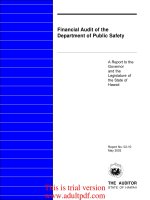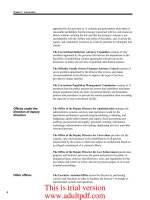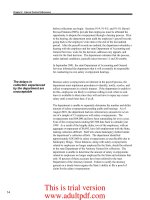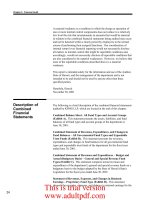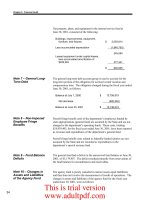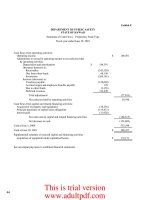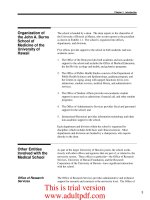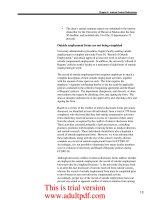Financial Audit of the John A. Burns School of Medicine of the University of Hawaii A Report to the Governor and the Legislature of the State of Hawaii Report No. 03-02 May 2002_part4 potx
Bạn đang xem bản rút gọn của tài liệu. Xem và tải ngay bản đầy đủ của tài liệu tại đây (46.91 KB, 11 trang )
26
Chapter 3: Financial Audit
School cash balances held by the university are pooled with other
university funds and are either federally insured or covered by collateral
held by the state director of finance in the name of the university.
School cash balances held by the foundation and RCUH are also pooled
with their other cash balances and amounts in excess of federally insured
limits are uncollateralized. The school’s cash and cash equivalents at
June 30, 2002 are held as follows:
At June 30, 2002, the school held cash amounts of $7,270,179 that were
subject to externally imposed purpose restrictions and are reported on the
statement of net assets as restricted cash and cash equivalents.
The composition of accounts receivable at June 30, 2002 is summarized
as follows:
The school operates the state’s Hyperbaric Treatment Center out of a
local hospital. At June 30, 2002, $770,554 of outstanding Hyperbaric
Treatment Center receivables due from patients and third party insurance
providers were included in nongovernmental accounts receivable;
$556,687 of this balance has been outstanding for more than 180 days
and is also included in the allowance for doubtful accounts. The
school’s total bad debt expense for FY2001-02 of $159,974 was due to
the increase in the balance of the allowance for doubtful Hyperbaric
Treatment Center accounts receivable from the prior year.
Student loans receivable is reported separately on the statement of net
assets in the amount of $55,110, net of an allowance for doubtful
accounts of $1,050 as of June 30, 2002. The school’s student loan
receivable accounts are administered under the foundation.
University of Hawaii $ 9,322,927
University of Hawaii Foundation 2,738,880
State Treasury 554,966
Research Corporation of the University of Hawaii 135,486
$ 12,752,259
Note 3 - Receivables
Federal government $ 2,622,636
State and local governments 3,413,974
Nongovernmental 2,283,674
$ 8,320,284
Less allowance for doubtful accounts (729,426)
Accounts receivable, net $ 7,590,858
This is trial version
www.adultpdf.com
27
Chapter 3: Financial Audit
Contributions receivable is also reported separately in the statement of
net assets in the amount of $251,034 as of June 30, 2002. There was no
allowance for doubtful accounts associated with this balance.
At June 30, 2002, school endowment investments with fair values of
$4,112,174 and $6,371,539 were held in investment pools in the
university and the foundation, respectively. Therefore, specific
information about the type of investments that comprise the school’s
endowment investment balance was not available. The university and
foundation’s endowment investment pools at June 30, 2002 were
comprised of the following investment types:
The cumulative appreciation in fair value of donor-restricted
endowments that are available for expenditure amounted to $306,487 at
June 30, 2002 and is reflected in restricted expendable net assets at year-
end.
At June 30, 2002, the school had $235,038 of short-term endowment
investments that were held by the foundation outside of the investment
pool to comply with donor restrictions. This balance was comprised
mainly of investments in domestic equities.
During FY2001-02, the school’s endowment investments (including
investments bought, sold, and held during the year) depreciated in value
by $1,483,114.
Capital asset activity for the year ended June 30, 2002 was as follows:
Note 4 - Investments
Note 5 - Capital Assets
University of
Hawaii
University of
Hawaii Foundation
Corporate stocks 71% 51%
Bonds 13 14
U.S. government obligations 16 9
Other 0 26
100% 100%
Beginning
Balance
Additions
Retirements
Ending
Balance
Furniture, fixtures, and
equipment
$
4,900,512
$
833,638
$
(225,918)
$
5,508,232
Less accumulated
depreciation
(3,517,473)
(399,498)
217,887
(3,699,084)
Capital assets, net $ 1,383,039 $ 434,140 $ (8,031) $ 1,809,148
This is trial version
www.adultpdf.com
28
Chapter 3: Financial Audit
Depreciation expense amounted to $381,858 in FY2001-02. The
difference of $17,640 between depreciation reported and total additions
to accumulated depreciation reflected above is due to the transfer of a
fully depreciated asset from another university unit in FY2001-02.
The loss on retirement of capital assets amounted to $8,031 in FY2001-
02 and is reflected in the statement of revenues, expenses, and changes in
net assets as a non-operating expense.
The net capital asset balance at June 30, 2002 includes capital assets held
under capital leases with a total net book value of $61,660.
Payroll fringe benefit costs related to employee salaries funded from
state appropriated general funds are paid directly by the State and not
imposed on the school. In FY2001-02, this cost amounted to
approximately $2,335,600 and is reflected as fringe benefit expense and
included in state appropriation revenue in the statement of revenues,
expenses, and changes in net assets.
Pension Benefits
Substantially all eligible employees of the school are members of the
Employees’ Retirement System of the State of Hawaii (ERS), a cost-
sharing, multiple-employer, public employee retirement plan. The ERS
provides retirement benefits as well as death and disability benefits.
Section 88, Hawaii Revised Statutes, establishes and amends benefit
provisions. Prior to June 30, 1984, the plan consisted of only a
contributory option. In 1984, legislation was enacted to add a new,
noncontributory option for members of the ERS who are also covered
under social security. Persons employed in positions not covered by
Social Security are precluded from the noncontributory option. The
noncontributory option provides for reduced benefits and covers most
eligible employees hired after June 30, 1984. Employees hired before
that date were allowed to continue under the contributory option or to
elect the noncontributory option and receive a refund of employee
contributions. All benefits vest after five and ten years of credited
service under the contributory and noncontributory options, respectively.
Most members of the contributory plan are required to contribute 7.8
percent of their salary.
The ERS provides basic pension benefits to individuals receiving
pensions. Employer contributions to the ERS are comprised of normal
cost plus level annual payments required to liquidate the unfunded
accrued liability of the ERS.
Note 6 - Payroll Fringe
Benefit Costs
Note 7 - Employee
Benefits
This is trial version
www.adultpdf.com
29
Chapter 3: Financial Audit
For the year ended June 30, 2002, total salaries for school employees
covered by the ERS and total salaries for all school employees were
approximately $27,977,600 and $33,843,300, respectively. The
university and school are periodically required to contribute an
actuarially determined amount to the ERS. The university and school
were not required to contribute to the ERS in FY2001-02.
The ERS issues a Comprehensive Annual Financial Report that includes
financial statements and required supplementary information, which may
be obtained by writing to the Employees’ Retirement System of the State
of Hawaii, 210 Merchant Street, Suite 1400, Honolulu, Hawaii, 96813.
The following data was obtained from the disclosures contained in the
Comprehensive Annual Financial Report for the year ended June 30,
2001:
Number of employers as of March 31, 2001:
Basis of Accounting
The financial statements of the ERS are prepared using the accrual basis
of accounting. Employer and member contributions are recognized in
the period in which the contributions are due. Benefits and refunds are
recognized when due and payable in accordance with the plan’s terms.
Method Used to Value Investments
Plan investments are reported at fair value. Where appropriate, the fair
value includes disposition costs. Short-term investments are reported at
cost, which approximates fair value. Securities traded on a national or
international exchange are valued at the last reported sales price at
current exchange rates. Mortgages are valued on the basis of future
principal and interest payments, and are discounted at prevailing interest
rates for similar instruments. The fair value of real estate investments
and real estate owned are based on independent appraisals and estimated
values.
Other Benefits
All regular employees, with certain exceptions, earn vacation leave at the
rate of one and three-quarters working days for each month of service.
Employees who are entitled to annual vacation may accumulate for the
State 1
Counties 4
Total employers 5
This is trial version
www.adultpdf.com
30
Chapter 3: Financial Audit
succeeding year or years up to 15 working days of their annual vacation
allowance, provided that the total accumulation shall not exceed 90
working days at the end of the calendar year. Accumulated vacation
leave, earned but not taken, is reflected as an accrual in the statement of
net assets and classified as current or noncurrent based on the estimated
payment date. When termination of services takes place, employees are
paid for their vacation allowance in a lump sum.
Sick leave accumulates at the rate of one and three-quarters working
days for each full month of service without limit, but can be taken only
in the event of an illness and is not convertible to pay upon termination
of employment. Accordingly, accumulated sick leave, earned but not
taken, is not reflected as an accrual in the accompanying financial
statements. Employees who retire with 60 days of unused sick leave are
entitled to three months of service credit in the system. For each
additional 20 days or major fraction thereof of unused sick leave they
have in excess of 60 days, their service period is increased by one month.
The school’s regular employees may enter into deferred compensation
arrangements directly with authorized insurance companies or agencies
through a payroll deduction plan. Accordingly, the school has no
deferred compensation or withholding payable.
In addition to providing pension benefits, the state provides certain
health care and life insurance benefits to all eligible employees who
retire from the school on or after age 62 with at least ten years of service
or age 55 with at least 30 years of service under the noncontributory
option, and on or after age 55 with at least five years of service under the
contributory option. Retirees credited with at least ten years of service,
excluding sick leave credit, qualify for free medical insurance premiums;
however, retirees with less than ten years must assume a portion of the
monthly premiums. All disability retirees who retired after June 30,
1984 with less than ten years of service also qualify for free medical
insurance premiums. Free life insurance coverage and dental coverage
for dependents under age 19 are also available. Retirees covered by the
medical portion of Medicare are eligible to receive a reimbursement of
basic medical coverage premiums. Contributions are based upon
negotiated collective bargaining agreements, and are funded by the state
as accrued. The school’s share of post-retirement health care and life
insurance benefits expenses for the year ended June 30, 2002 was
approximately $541,150.
Capital Leases
Capital leases of equipment are recorded at the lower of the present value
of the minimum lease payments or the fair market value of the asset at
Note 8 - Post-
Retirement Health Care
and Life Insurance
Benefits
Note 9 - Lease
Obligations
This is trial version
www.adultpdf.com
31
Chapter 3: Financial Audit
acquisition. Interest rates on capitalized leases vary from 10.5 percent to
12.3 percent. Future minimum lease payments as of June 30, 2002 are as
follows:
Operating Leases
The school leases space for certain research and training activities,
including a hyperbaric treatment center and a geriatric teaching center.
These non-cancelable operating leases expire at various dates through
FY2003-04.
Future minimum lease payments under these operating leases are as
follows:
Long-term liability activity for the year ended June 30, 2002 was as
follows:
By statutory provision, the university prepares a biennium budget for its
programs. Budgeted expenditures are derived primarily from Act 259,
Session Laws of Hawaii (SLH) 2001, as amended, and from other
specific appropriations acts in various Session Laws of Hawaii.
Year ending June 30,
2003 $ 21,615
2004 18,205
2005 13,863
2006 10,710
2007 2,741
Total minimum lease payments $ 67,134
Less amount representing interest (12,565)
Present value of future lease payments $ 54,569
Year ending June 30,
2003 $ 241,260
2004 90,920
Total minimum lease payments $ 332,180
Note 10 - Long-Term
Liabilities
Note 11 - State
Appropriation Revenue
Beginning
Balance
Additions
Reductions
Ending
Balance
Current
Portion
Accrued
vacation
$
1,134,279
$
516,276
$
(326,372)
$
1,324,183
$
699,698
Capital lease
obligations
21,322
41,522
(8,275)
54,569
15,393
Total
long-term
liabilities
$
1,155,601
$
557,798
$
(334,647)
$
1,378,752
$
715,091
This is trial version
www.adultpdf.com
32
Chapter 3: Financial Audit
The school’s share of state appropriations amounted to $15,612,246 in
FY2001-02, including $1,346,893 allocated by the university specifically
for the Office of Public Health Studies. This amount is combined with
non-imposed fringe benefits of approximately $2,335,600 and reported
as non-operating state appropriation revenue on the statement of
revenues, expenses, and changes in net assets.
The school purchases commercial insurance directly from an insurance
agent for professional medical malpractice coverage. In addition, the
school administers the Medical Malpractice Self-Insurance Reserve Fund
to fund costs arising from the defense and settlement of malpractice
claims. The reserve was established in 1977 by the Hawaii State
Legislature as a special fund account. The net assets related to this
reserve amounted to $431,768 at June 30, 2002. No expenditures were
made out of this reserve in FY2001-02.
The state risk pool and university-purchased commercial insurance
policies cover school exposure to various risk of loss related to general
tort, education-related tort, theft, damage, errors and omissions, injuries
to employees, and natural disasters.
The school participates in the university’s self-insurance program for
unemployment and workers’ compensation claims. In FY2001-02, the
school was assessed a premium based on a percentage (1.45 percent and
.2 percent for workers’ compensation and unemployment insurance,
respectively) of the salaries of covered employees that are compensated
for at least 50 percent time. In return, the university assumes the risk of
loss for all current and future claims by school employees. In
accordance with GASB Statement No. 10, Accounting and Financial
Reporting for Risk Financing and Related Insurance Issues, as the
school does not retain the risk of loss, no liability for unpaid claims has
been recorded in the accompanying financial statements.
Liabilities related to losses are reported when it is probable that the
losses have occurred, the amount of those losses can be reasonably
estimated, and the risk of loss is retained with the school. No such
liabilities have been reported for the school as of June 30, 2002.
There have been no reductions in insurance coverage from coverage in
prior years or settlements in the past three fiscal years that were in excess
of the school’s insurance coverages.
An encumbrance system is used by the school to record outstanding
purchase orders and other commitments. This system is used for budget
control purposes and no expenses or liabilities are recorded in the
school’s financial statements until the related goods or services have
Note 12 - Commitments
and Contingencies
This is trial version
www.adultpdf.com
33
Chapter 3: Financial Audit
been received. At June 30, 2002, unrestricted and restricted net assets of
approximately $375,000 and $4,190,000, respectively, were reserved in
the school’s encumbrance system for commitments. To the extent that
state appropriated funds are not encumbered at year-end or are
encumbered but not paid by a specified period of time after year-end,
these funds generally lapse and are returned to the state.
As of June 30, 2002, various sponsoring agencies had awarded the
school research and training contracts and grants for which the school
had yet to meet the associated eligibility requirements that would enable
revenue recognition in the accompanying financial statements. Most of
the eligibility requirements deal with incurring the appropriate expenses
allowed for under the contracts and grants in the appropriate time period.
At June 30, 2002, the school held an estimated $72.5 million in contract
and grant funds available to be spent in varying time periods ranging
from one to five years. Approximately $4,391,765 of this balance is
reported as a deferred revenue liability to reflect the unearned revenue
associated with funds received in advance from sponsors. The following
comprises the deferred revenue balance at June 30, 2002:
Both the university and the State of Hawaii provide certain accounting
and general administrative services and facilities to the school. The
costs of some of these services and facilities are not reflected in the
accompanying financial statements.
The University Clinical, Education, and Research Associates, Inc.
(UCERA – formerly known as University Health Care Associates, Inc.)
is a separately incorporated not-for-profit corporation, which contributes
to the school’s goal of improving the health care status of the citizens of
Hawaii and Pacific area by supporting the academic mission of the
school. The organization functions as a practice plan for faculty of the
school, providing a vehicle by which clinical revenues can be generated
on a limited scale during their non-university, private practice time. The
financial information of UCERA has not been included in the
accompanying financial statements because the school and university are
not financially accountable for this entity. Contracts for professional
services are regularly entered into between the school and UCERA. In
FY2001-02, total expenditures to UCERA under these agreements
amounted to $196,940, including $67,066 in extramurally funded
expenditures. Total receipts from UCERA amounted to $111,023 in
Federal government $ 809,010
State and local governments 2,323,329
Nongovernmental 1,259,426
Total deferred revenues $ 4,391,765
Note 13 - Related
Parties
This is trial version
www.adultpdf.com
34
Chapter 3: Financial Audit
FY2001-02. Amounts due to UCERA at June 30, 2002 amounted to
$233,530 and have been included in accounts payable. There were no
amounts due from UCERA at June 30, 2002.
The Hawaii Residency Program, Inc. is a separately incorporated not-for-
profit corporation that coordinates the administration of Hawaii’s
residency training programs through a joint effort between the school
and several of Oahu’s major hospitals and medical centers. The goal of
this coordinated effort is to minimize the aggregate cost of conducting
residency training programs while maximizing the benefits and quality of
the educational experience for the residents. The financial information
of the Hawaii Residency Program, Inc. has not been included in the
accompanying financial statements because the school and university are
not financially accountable for this entity. The school contracts with the
Hawaii Residency Program, Inc. to provide training services. In
FY2001-02, total school expenditures to the Hawaii Residency Program,
Inc. amounted to $865,964, including $809,222 in extramurally funded
expenditures. Amounts due to the Hawaii Residency Program, Inc. at
June 30, 2002 amounted to $145,611 and have been included in accounts
payable. There were no amounts due from the Hawaii Residency
Program, Inc. at June 30, 2002.
UCERA’s financial statements were examined by separate independent
auditors whose audit report has been provided to the school. The school
obtained unaudited financial statements from the Hawaii Residency
Program, Inc. as it was not audited in FY2001-02.
The following is a condensed summary of the combined financial
statements for these organizations based solely upon the financial
information provided to the school (unaudited):
This is trial version
www.adultpdf.com
35
Chapter 3: Financial Audit
The university is in the process of constructing a new biomedical science
research and education campus, which will house major components of
the school’s operations. The new campus site is comprised of 9.1 acres
in the Kakaako Waterfront area of Oahu. The project is currently in
phase one, which includes the construction of an education and
administration building and a biomedical research building. The
buildings will comprise over 317,000 net square feet of space. The
education and administration building will include:
• Educational classrooms,
• Simulation and distance learning center,
• Auditorium,
• Bookstore,
• Faculty and staff offices, and
• Cafeteria and dining area.
Assets
Current Assets $ 6,710,668
Noncurrent Assets 202,596
Total Assets $ 6,913,264
Liabilities
Current Liabilities $ 3,325,556
Noncurrent Liabilities
Total Liabilities $ 3,325,556
Net Assets
Restricted Net Assets $ 15,858
Unrestricted Net Assets 3,571,850
Total Net Assets $ 3,587,708
Revenues, Expenses, and Changes in
Net Assets
Total Operating Revenues $ 15,866,434
Total Operating Expenses (16,293,717)
Operating Loss $ (427,283)
Nonoperating Revenue, net 183,796
Decrease in Net Assets $ (243,487)
Net Assets – Beginning of year 3,831,195
Net Assets – End of year $ 3,587,708
Note 14 - New
Biomedical Science
Campus
This is trial version
www.adultpdf.com
36
Chapter 3: Financial Audit
The biomedical research building will include:
• Research labs,
• Animal research facility,
• Research support offices,
• Mechanical equipment, central power plant, and loading docks,
• Materials management, and
• Child care and fitness center.
Under Act 281, SLH 2000, the Hawaii State Legislature appropriated
$875,000 for a project feasibility study. Under Act 251, SLH 2001, the
Legislature appropriated $13 million to fund costs of architectural
engineering services, design services, and the relocation of displaced
tenants. Act 14, SLH 2001, Third Special Session, authorized the
university to issue $150 million in revenue bonds to finance the
construction of a new biomedical science campus and pledged the
support of the State tobacco settlement funds to pay the bonds. The
bonds are also backed by the assets of the university.
Demolition and site work began on September 15, 2002 and October 24,
2002, respectively. The education and administration building is
expected to be completed in September 2004 and the research building is
expected to be completed in July 2005.
The school has assumed fiscal and administrative responsibility to
support these construction activities, but has not capitalized the
construction in progress costs or the associated debt in the accompanying
financial statements. These costs are reported on the university’s
financial statements, and amounted to approximately $10.3 million as of
June 30, 2002. These amounts include approximately $7.1 million for
the relocation of displaced tenants.
This is trial version
www.adultpdf.com
